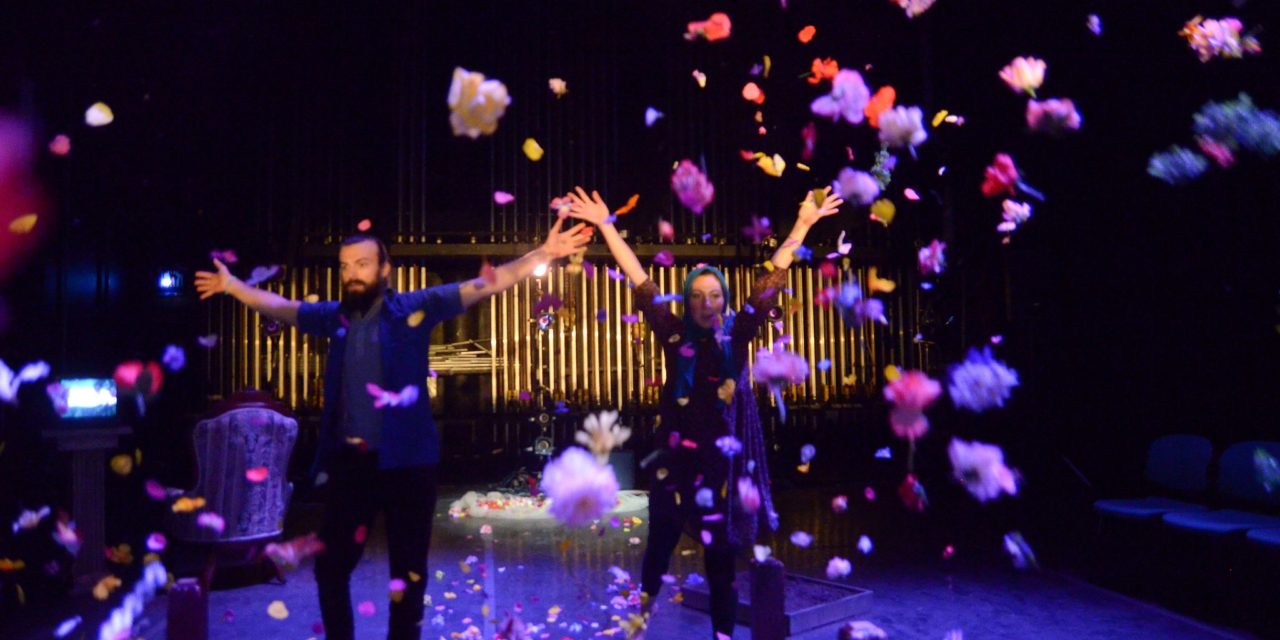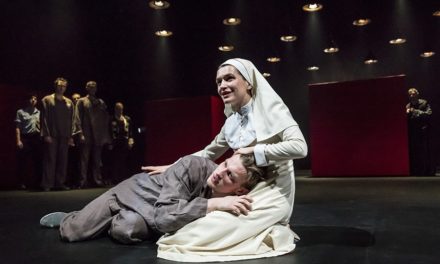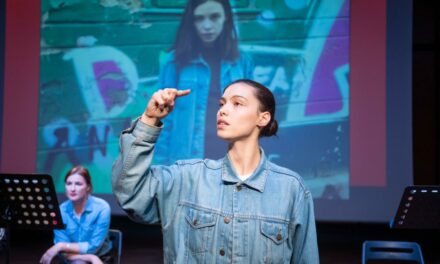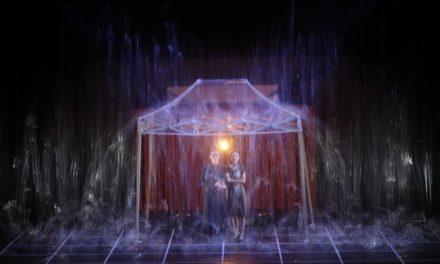The evening that I saw Red Wednesday by Built for Collapse at the LaGuardia Performing Arts Center, there was an illustration of Iran’s Mohammad Reza Shah Pahlavi and former Supreme Leader Ruhollah Khomeini on the cover of the Wall Street Journal. For a play that examines the human experience of the Iranian Revolution in 1979 through a multimedia exploration of text and movement, it felt like a sign, particularly in light of the recent nuclear negotiations between the United States and Iran. This fact certainly has not eluded the company members, all of whom have been following the negotiations with an avid interest. Director Sanaz Ghajarrahimi says, “We’re in a weird spot right now, a place of unstable hope. We fight like we’re fighting a war, but it’s really a battle in a war that China is going to win, while we’re just pawns.”
She cites the likely impending change in leadership for both countries (given the 2016 American election and the unstable health of Supreme Leader Ali Khamenei). Red Wednesday is a thoughtful production by an up and coming theater company based in Brooklyn, with its sights set on an international stage.
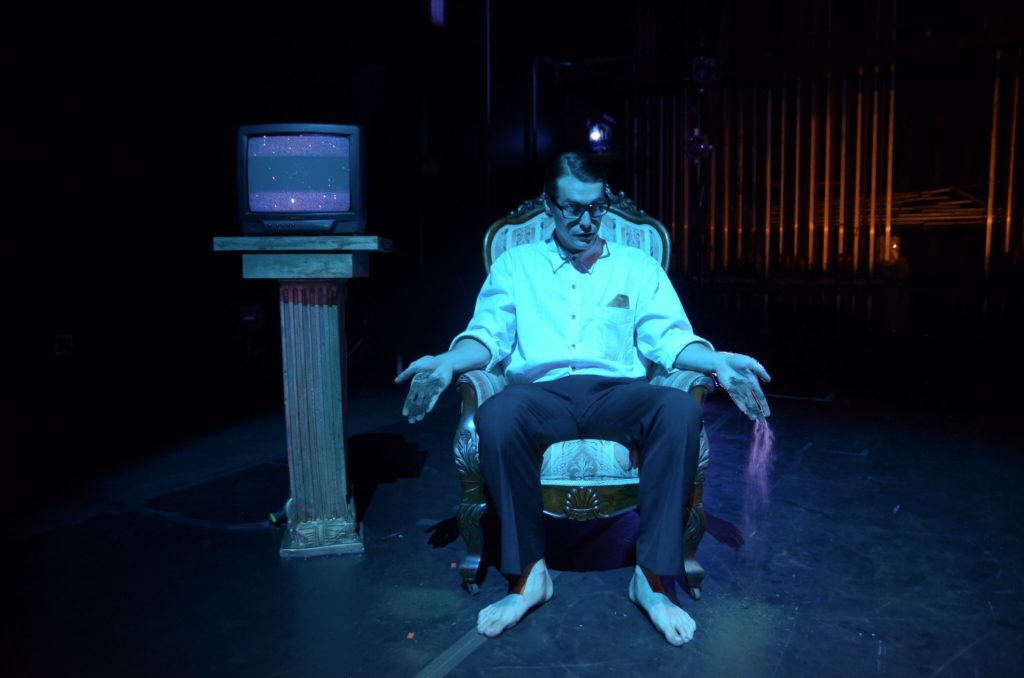
Performance of Red Wednesday at LaGuardia. (c) Built for Collapse
For a company that is able to negotiate such a sensitive and complicated emotional and political story with artistry and finesse, the giddy energy that drives conversation between Built for Collapse’s company members–Sanaz Ghajarrahimi, Ben Hobbs, and Vincent Santvoord–is reminiscent of the sort of long, profound talks held in undergraduate bedrooms. And yet, their prodigious work ethic has led them far from the New York University dorm rooms and rehearsal spaces where they got their start. Having produced thirteen shows over their six-year career, and toured internationally for the past three consecutive years, Built for Collapse is an ambitious young company that is full of itself, and for good reason.
The company started with $3,000, a graduation gift which they recycled four times on four different productions, earning it back in ticket sales each time. Their early work was classical, but they now produce “multi-disciplinary work that challenges theatrical form, [developing] work through an ever-evolving process that involves original writing and choreography inspired by found texts, visual art, and pop culture.”
Their name comes from an air rights protest poster they saw in Brooklyn, proclaiming that the incoming high rise buildings were “built for collapse.” It’s an apt description of both their aesthetic and their process. Since they often tour their productions, it is important to create pieces that can literally be broken down and put back together again. In addition, not only does each piece tend to commence in a “clean” way and then descend into a stage covered with debris by the end of the show, but they are far from precious about their work. In creating their first full-scale production, Nuclear Love Affair, a piece about America in the era of the atomic bomb, they ended up with a show that was one hour long out of three hours of usable material. Ghajarrahimi says, “We tell our actors nothing is precious because our real question is, what is the audience going to get out of it?”
They learned early about the value of exposure to international work, and they have been touring internationally since 2012. Their first international tour started at the Prague Fringe Festival (where they received the “Inspiration Award” for Best New Work), and from there they traveled to Poland and Germany. “It’s boring to just make work and do it here,” says Ghajarrahimi, “you get stuck in the type of work you’re making.”
Since their first European tour, they have traveled as a company to Bulgaria, Rome, and Istanbul. They are fiercely proud and protective of their work since they are familiar with the obstacles that come with different measures of formally recognized “success.” Instead, they are building this company, and their productions, by their own rules. Santvoord says, “Sheer willpower has gotten us to where we are now.”
In hiring actors and designers, they like to work with people who share their creative impulse, people who want the challenge and will be lit on fire by the way that they work. They admit that sometimes this creates conflict with collaborators who are not prepared to deal with so many last minute changes and agree “expectation management” has been an important lesson in the growth of their company. Ghajarrahimi says, “I don’t believe in communism. As long as the goal is the same, you have to trust each other to take over. And democracy is a lie.”
And so, while the three collaborators work together on every project, they have learned to trust each other to take the reins at different stages of creation and development. Although they wear a number of different hats in producing a piece, primarily, Ghajarrahimi is the director, Hobbs is the choreographer (with a visual art background), and Santvoord is an actor, who flips back and forth between his role as Development Director for the company and his many roles in the pieces they produce. In describing their dynamic, Ghajarrahimi says, “We get in fights all the time, but they’re good fights, like a family trying to choose which vacation to take.”
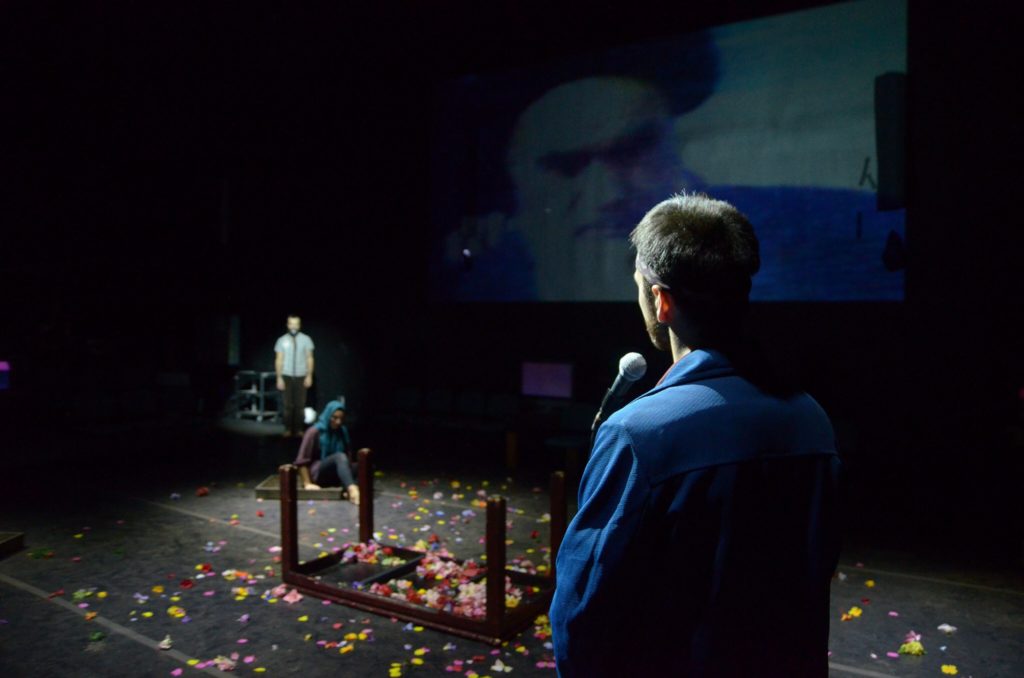
Performance of Red Wednesday at LaGuardia. (c) Built for Collapse
Despite the tremendous amount of research the creative team puts into the development of each production, they do not consider their work to be “documentary” theater, nor do they emphasize the fact that many conversations are vital to the textual fabric of their work by approaching or labeling them as formal interviews. Instead, their work tends to be an experiment in multimedia and storytelling, sharing their version of how they imagine real events would have felt if they had lived them.
For Red Wednesday, Ghajarrahimi says they did a lot of research into myth and framed the piece around our mythic take on what human experience is, “aiming to be emotionally rather than historically accurate because that’s where truth comes from.” Since their plays have spent so much time in the workshop, they rely on audience feedback during the developmental process to keep their focus on the heart of the story. In the development of Nuclear Love Affair, Hobbs says, “We got a lot of comments from older people who had lived through that era saying, nope, that’s not how it was, but wow, I can see how your generation sees it that way.”
The development of Red Wednesday veers closer to the format of documentary theater, although Built for Collapse still does not classify it as such. Ghajarrahimi says, “For years I tried to do anything but [Red Wednesday], even though everyone was telling me I should because I have a unique lens as an Iranian woman and a great family story to tell. But I thought it had to be film.”
Then the Arab Spring and Occupy Wall Street came along, and all of a sudden the piece felt much more relevant, enabling Ghajarrahimi to envision the story unfolding on stage. Although the story began with interviewing members of Ghajarrahimi’s family, including her mother, father, stepmother, grandfather, both grandmothers, and another uncle, about her deceased uncle’s experience in the Iranian Revolution of 1979 and the toll it took on their extended family, they later expanded their conversations to include people on both sides of the conflict. Ghajarrahimi emphasizes, “It’s not about my uncle, it’s about revolution.”
Over the course of two trips to Istanbul (taken for other purposes than researching Red Wednesday), they were even lucky enough to have the opportunity to speak with young people who currently live in Iran, including Syrians, NGO workers, and a Turkish woman who attended the Occupy Gezi protest. They watched movies on Netflix, read books and internet material about the revolution, and sought out the mass media, music, and television of that time period in Iran and the United States, likening their research process to following a Reddit link down a deep rabbit hole of the internet, since every person they spoke to suggested another film, or book, or contact
Once they had gathered all their source material, they created an image outline like you see in detective shows, involving several sheets of poster board and the images that they felt were vital to their story. In fact, when they began rehearsal, the script was just a collection of images, and they used the actors’ emotional reactions from those images to structure the storytelling.
“Finding the wording is always the most difficult,” Hobbs says. “We can always agree on the images, if not the words.”
The version of Red Wednesday that was performed in the Rough Draft Festival at LaGuardia Performing Arts Center in late March had a complete first act and the barebones of a second act. Typical to their over-generative style, of the twenty minutes presented from the second act, they predict they will keep about five. They hope to premiere a full production of Red Wednesday on Red Wednesday (Chaharshanbe Suri, an Iranian holiday that marks the arrival of spring), the third Wednesday of March in 2016. They would also like to tour this production in the United States since they feel the conversation it induces is particularly helpful for Americans who have such a disconnect between their image of Iran and the reality of the recent nuclear negotiations.
Hobbs says, “We’re so similar, really, there’s a good guy/bad guy story in American politics, and it’s the same thing in Iran.”
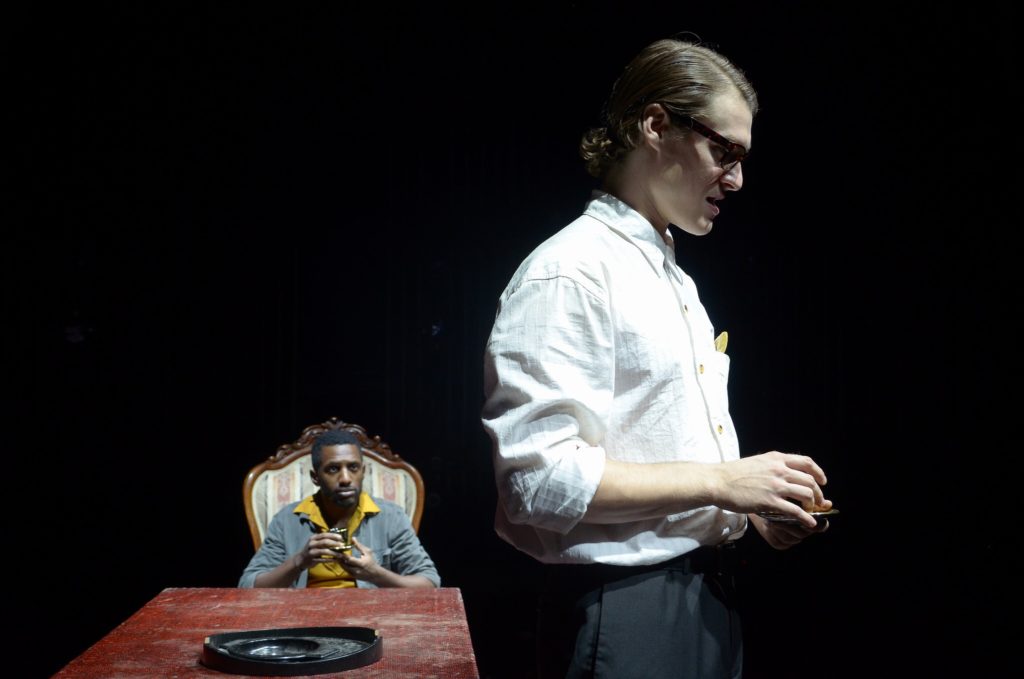
Performance of Red Wednesday at LaGuardia. (c) Built for Collapse
This piece is particularly intriguing in the way that it reaches out to its audience. Since the intended audience is peers of the company members, who probably were not yet born when the Iranian Revolution happened, the first act is laden with dialogue explaining the historical and political significance of the events unfolding. In doing so, Red Wednesday explains the historical context for this conflict and underscores it with captivating choreography, including a series of “call to prayer” movements and a silent vaudevillian comedy act. The actors deliver highly physical performances, allowing the audience to complement their understanding of the facts with the internal emotional reality of the characters.
From the audience feedback of this production, Built for Collapse has observed that Americans tend to focus on the tragic elements of the story, whereas foreign audiences’ feedback is less predictable. “In Prague, the audience sat there stone-faced through the entire production, and then had a lot to say afterwards, whereas in Rome, the audience laughed through the whole thing and left without saying anything afterwards.”
Presenting work in a foreign city is always an experiment in cultural exchange, but this piece is particularly interesting to tour because of the contemporary global connection to this conflict. Ghajarrahimi and Santvoord will travel to festivals in Manchester and Lisbon this summer to do further developmental research for Red Wednesday, in order to understand international viewpoints and currents of discussion on the Iran-American nuclear deal, since the second act is about globalization.
If you don’t want to wait all the way until next year to see Red Wednesday, next up, the group will be performing a version of their latest play about lobotomy, Unremarkable, at the Theater for the New City LES Festival in May. They will also host a free public reading of Red Wednesday this fall in Brooklyn, with support from the Brooklyn Arts Council. This is a young company worthy of admiration for its artists’ steadfast creative vision and experimental form, taking liberties with history while preserving the immediate and striking emotional experience that live theater enables.
This post was written by the author in their personal capacity.The opinions expressed in this article are the author’s own and do not reflect the view of The Theatre Times, their staff or collaborators.
This post was written by Amelia Parenteau.
The views expressed here belong to the author and do not necessarily reflect our views and opinions.

